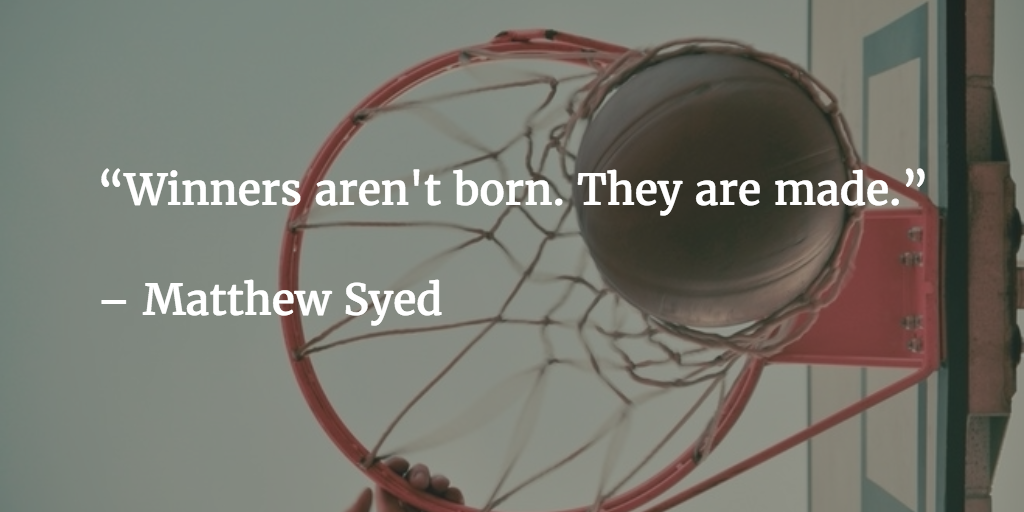1-Sentence-Summary: Bounce shows you that training trumps talent every time, by explaining the science of deliberate practice, the mindset of high performers and how you can use those tools to become a master of whichever skill you choose.
Read in: 4 minutes
Favorite quote from the author:

Audio Summary
Listen to the audio of this summary with a free reading.fm account*:
I remember Tai Lopez kept raving about this book back in 2014. Matthew Syed is a former table tennis professional, who was the number one English player for several years and went to the Olympics twice. Since 1999, he writes for The Times. Bounce was his first book about how high performers like himself achieve their success.
Here are my takeaways:
- With intense practice, 2 changes will occur in your brain to make it more effective.
- Even minor details can inspire you to work hard for your success.
- You can avoid choking under pressure by telling yourself that it’s not a big deal.
Let’s look at what it takes to be successful in detail!
Lesson 1: When you practice a lot, 2 changes will make your brain more effective.
Table tennis players often seem to have lightning fast reaction times, right?
But when scientists ran a bunch of tests on the English national team’s players, they found the best player, Desmond Douglas, to have the slowest reaction times.
How does this go together?
Douglas’s brain has been trained to quickly assess situations in a table tennis match, through years of practice, but only when he’s playing.
Because he’s seen so many balls fly towards him in so many different ways, his brain can easily estimate even the most complex trajectories and give him more time to react than other players with less practice.
However, that doesn’t make him a better driver. In an everyday car crash, he wouldn’t hit the brakes any faster than you or me.
The second thing that happens is that his brain uses other areas to perform than the brain of a beginner. Since a lot of his actions happen on autopilot, the subconscious parts of his brain are really in charge here.
Instead of wasting the resources of his prefrontal cortex on trying to get the ball spin right, he can use his brain to think about tactics, because the movements of his hand are taken care of.
Lesson 2: You can be inspired to work hard by the most trivial details.
Do you know the story of the 4 minute mile?
Basically, for thousands of years humans believed it was not possible to run a mile in less than 4 minutes.
It seemed like the human body just wasn’t capable of doing it.
The record stalled in the 1940’s, for 9 years no one could get past 4:01.
Then, in 1954, Roger Bannister finally broke the mark.
Within a month, another guy did it. Over the next 4 years, 20 more people broke the barrier, bringing the record all the way down to 3:56.
When the hell did it become so easy for so many people?
The moment someone did it, that had even the slightest relation to them.
11 of those 20 people come from UK-related countries (Ireland, NZ, AUS). Roger Bannister was British.
Syed calls this motivation by association. He says if we find even the slightest similarity between someone successful and ourselves, it can motivate us to multiply our work efforts.
Lesson 3: You can tell yourself an event is not a big deal to avoid choking under pressure.
What happened to Eminem when he finally got his shot to show everyone how good he was at rapping live on stage? He choked.
Looking into hundreds of faces, knowing they were all expecting him to fail, the pressure to perform became so enormous, that all his hardly trained rhyming skills seemed to vanish.
What can happen to all performers in such a high pressure situation, is that their conscious brain takes over, because it usually allows them to take extra caution and be very alert of every movement, so they don’t make a mistake.
However, when it’s all on the line, that’s not exactly what you want. It’s right in those moments that you want your subconscious to be in charge, so you can actually reap the benefits of all your hard training.
You can combat this performance anxiety by telling yourself that it’s really not such a big deal and that the event doesn’t matter to you.
Compare it to your health, your family, your spouse or your best friends – does it really matter whether you win or lose the Super Bowl?
This will allow you to stress less and unleash your hard earned skills.
And sure enough, once he stopped giving a damn about the whole event or what everyone thinks of him, Eminem went back and crushed it.
Bounce Review
I’m big on deliberate practice and so is Bounce. Naturally, we got along quite well. Syed also touches on related topics, such as having a fixed mindset and building confidence. Combine this with the reminder that you need incredible focus on one area from Zero To One yesterday, and you have a great recipe for success.
I like the many examples this summary used and am sure there are many more in the book plus links to some of the studies Syed quotes, which are hard to find otherwise. Look at whether the summary on Blinkist strikes you and if it does, grab a copy of Bounce!
Who would I recommend the Bounce summary to?
The 13 year old who is about to give up playing the piano, the 22 year old who loves his college football team, but is not quite sure he can make it into the NFL, and anyone who ever choked at an important event.
Last Updated on July 27, 2022